#early ownership ford
Explore tagged Tumblr posts
Note
OMG MORE EARLY OWNERSHIP FORD I JUST SAW THE LAST COMIC OF IT I NEED MOREEEE (only if u want to ofc)
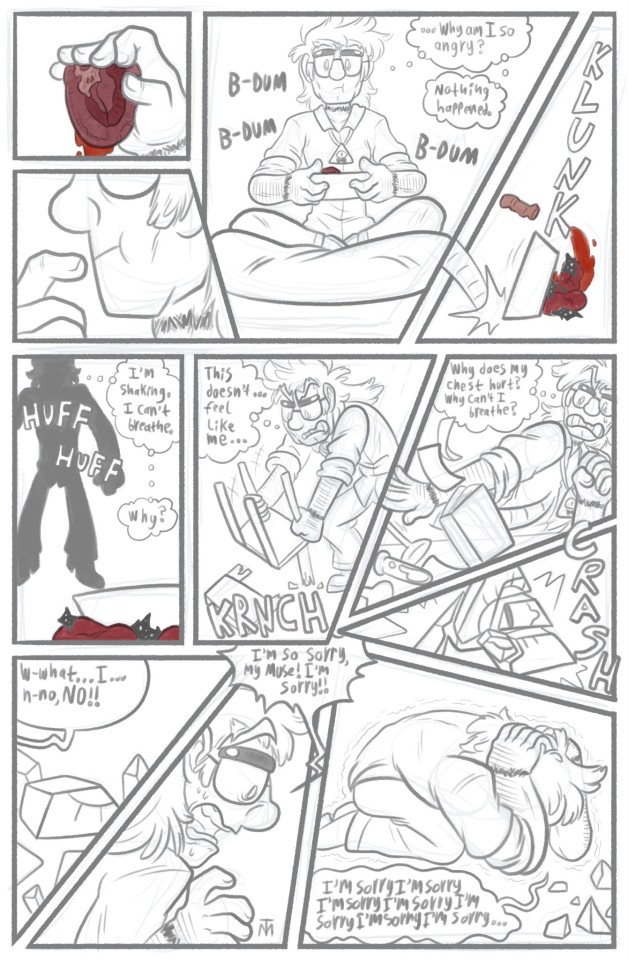
His brain and body weren't always in accord with each other back then
#gravity falls#gravity falls au#domesticated ford#ford pines#stanford pines#my art#sketch#ask#comic#tw gore#early ownership ford#disassociation#Ford was being too cute i had to bully him again#now i have a picture of a beef kidney on my phone#let's just... hope this one is beef too#i think it might be too small for that though#don't tell him
221 notes
·
View notes
Text
Today was a very good day.
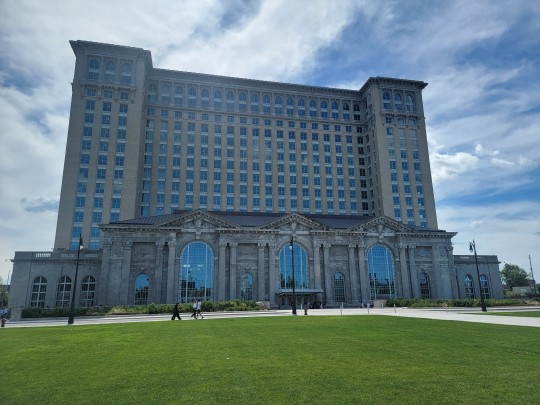
We went to tour Michigan Central Station, and it was spectacular. This train station was the main transit hub in Detroit from 1914 to 1988. If you aren't from here, it's important that you know it was owned by a local billionaire who just let it rot. It was in horrible shape, flooded, every window broken, and pillaged of all of its relics.

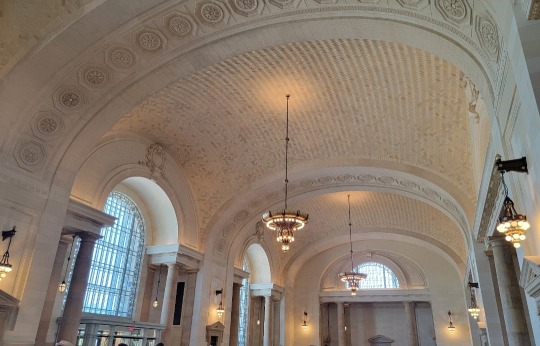
But, while it was a sad broken building, it was also home to tons of amazing graffiti art. Ford bought the building in 2018 and began a huge undertaking of restoring it. I could write pages about all the amazing restoration. Thousands of people put in millions of hours. I figured all the graffiti was lost to the renovation.
I was so excited to see that they saved an entire hallway of the original artwork, and I saw this exhibit today.
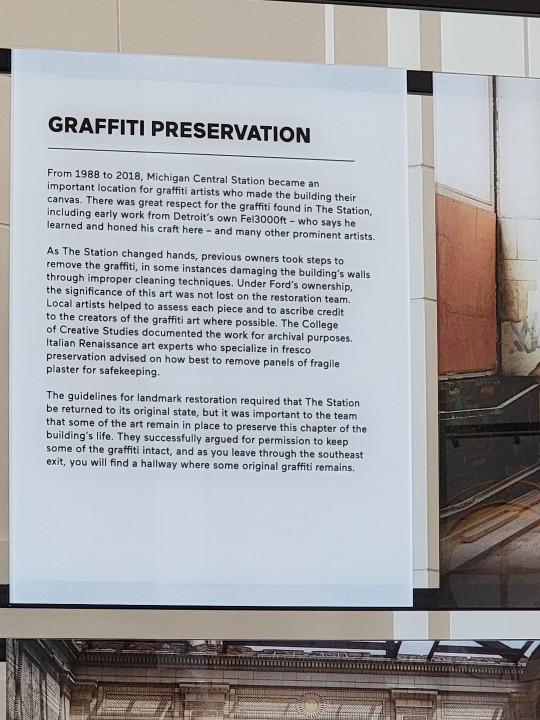
Here is the text if it's hard to read:
GRAFFITI PRESERVATION
From 1988 to 2018, Michigan Central Station became an important location for graffiti artists who made the building their canvas. There was great respect for the graffiti found in The Station, including early work from Detroit's own Fel3000ft- who says he learned and honed his craft here - and many other prominent artists.
As The Station changed hands, previous owners took steps to remove the graffiti, in some instances damaging the building's walls through improper cleaning techniques. Under Ford's ownership, the significance of this art was not lost on the restoration team. Local artists helped to assess each piece and to ascribe credit to the creators of the graffiti art where possible. The College of Creative Studies documented the work for archival purposes Italian Renaissance art experts who specialize in fresco preservation advised on how best to remove panels of fragile plaster for safekeeping
The guidelines for landmark restoration required that The Station be returned to its original state, but it was important to the team that some of the art remain in place to preserve this chapter of the building's life. They successfully argued for permission to keep some of the graffiti intact, and as you leave through the southeast exit, you will find a hallway where some original graffiti remains.
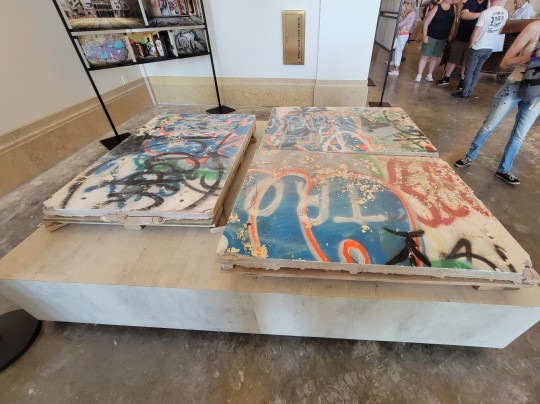
I love this vibrant city, and I'm excited that if we have to have everything owned by billionaires, that we switched this building to one who has reverence for Detroit and all that makes it beautiful.
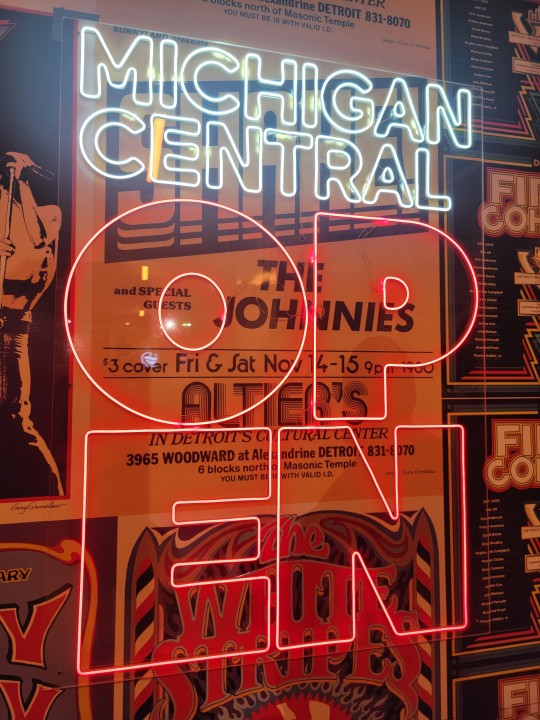
523 notes
·
View notes
Text

Fall for Tom Ford
Details
Custom Thumbnail
Teen- Elders
Female
Two Piece (10 Swatches)
Credits:
Original Mesh
Sims4Studio
Blender 3.3
Additional Credit:
Rendered by @kxngkerisha
Terms Of Use:
Do Not Share My Content (Always Early Access)
Recolors Allowed (Personal while Early Access.)
Don't take ownership of anything that I create.
Only include my things in your download if it is already free; otherwise, do not feel the need to link back to me unless it's just a nice shoutout because you like my creations and would like to bring awareness! AGAIN, this is only if my creations are already free. If it is still under Early Access, then please link back to me for people to download
Download Here (Early Access)
127 notes
·
View notes
Text
Covered in asphalt or gravel, the area behind the house was “a utilitarian space where trash was burned, clothes were washed and hung up to dry, and unneeded household items were left to rust.” It was in front of the house that children played, in the yard or in the street, in view of the neighbors. The border between private and public space was the porous alcove of the front porch, a place for supervising those kids, flirting with a classmate in the respectability of the public view, snooping on neighbors doing the same, or adroitly greeting relatives or salesmen who weren’t quite welcome inside the domestic sanctum. […]
In the 1920s, the backyard began to supersede the front porch as the primary domestic outdoor social space. This switch would be accelerated by the arrival of indoor enjoyments like television and air-conditioning, as well as appliances like washers and dryers, which freed the backyard from its workaday purpose, but it began with the automobile. Prior to widespread car ownership, streets were multifunctional public places suitable for hawkers and markets, stickball games and snowball fights, the storage of construction materials, and waste disposal. The roaring car traffic associated with Henry Ford’s Model T cemented the street’s sole purpose as a thoroughfare. […] The suburban cul-de-sac was the fruit of newly widespread car ownership—and a refuge from it. In 1922, House Beautiful noted strains of front porch fatigue: “the increase in motor-traffic, the dust and proximity of other houses tend to make the front porch less desirable each year . . . One prefers [porches] turned away from the trivial drama of the street with its hucksters and milk wagons and gossip.”
At the Tenth National Conference on Housing in 1929, one speaker declared that the dirty old backyard, of all places, could be repurposed to offer “charm and sanctuary from a too noisy world”—away from “front porch promiscuity.” But it was less the question of how cars moved than of where to keep them that changed the shape of the American house. This shift from front porch to backyard coincided with the forward march of the garage, out of the backyard and into the house itself, as the car (later, cars) assumed its prime place in family life. Wright led the way. With his Usonian houses, a series of middle-class dwellings he designed beginning in the 1930s, America’s foremost architect invented a new word, carport, to describe an attached, sheltered overhang for car storage. […] He preferred the carport to the attached garage for the same reason he disliked basements: closed garages were likely to become just another place to gather household clutter.
Nevertheless, the implements of the closed, attached garage were all in place and awaiting the postwar housing boom. Overhead garage doors were commonplace by the 1910s, electric garage door openers by the 1930s. Early subdivisions may not have had interior spaces for cars—at the most famous of them, Levittown, east of New York City, the entire house was barely the size of a modern three-car garage—but the attached garage became de rigueur in the 1950s as mass-transit ridership plummeted and the car reinforced its dominance.
10 notes
·
View notes
Note
Tell us about your current and past motor vehicles
gladly! this is gonna be a long post
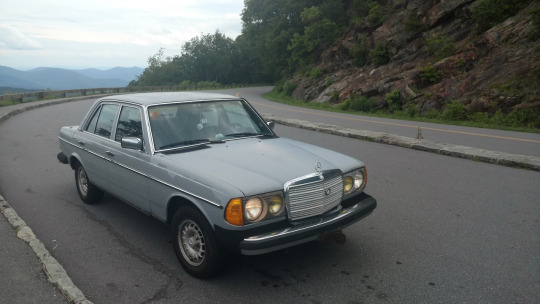
this was my first car, she was a 1984 mercedes 300D turbodiesel. her name was clifford, named after a button on the dash from a defunct security system. in-line five diesel engine, sounded like a truck, was built like a truck, LOVED this car. i paid $600 for her in 2016. she had 308k miles when i bought her, and she went to the scrapyard with 314k the next year when the hood latches broke while i was on the highway and sent the hood into the windshield. i was okay but the repairs were just too much for a $600 car. she was awesome though, a real head turner even with her peeling clearcoat and plumes of diesel smoke
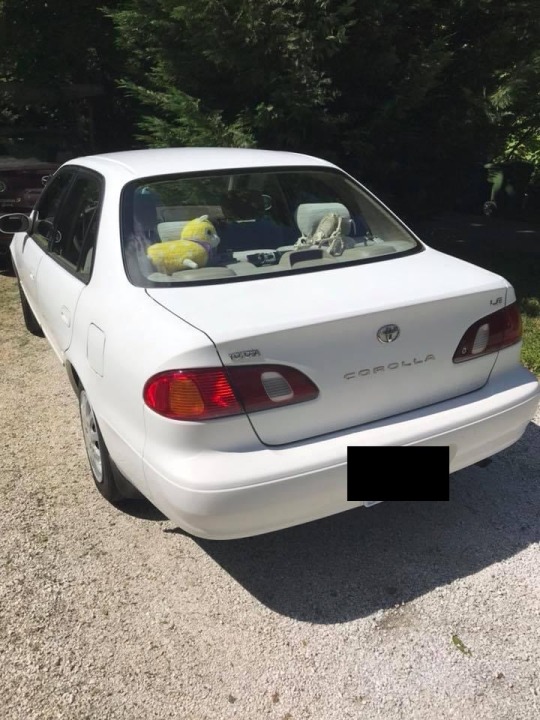
then there was the corolla! 1999, manual transmission. the best car i’ve ever owned. not my favorite but definitely objectively the best. bought off a friend also for $600, around 210k miles. surprisingly fun to drive, very reliable. drove from north carolina to massachusetts in that car, and then across massachusetts every week. her name was wanda, which carried over from the previous owner. drover her for a little over a year before the brakes failed and i rear ended someone
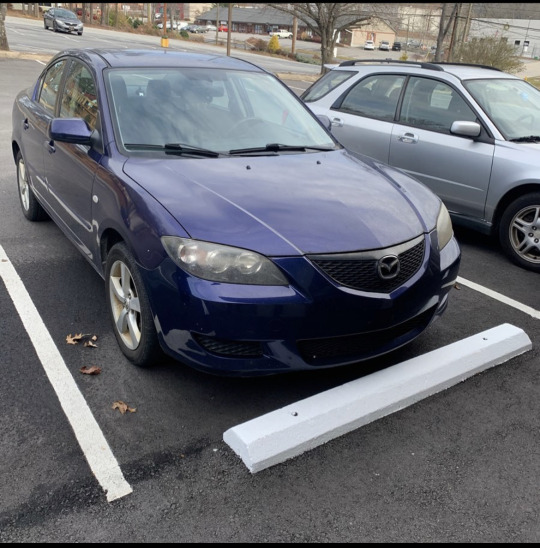
i replaced the corolla with an ‘05 mazda3 i called the tick, after the cartoon character. also bought from a friend. kept it through early 2021 i think, drove it through most of early quarantine. i didn’t love this car personally, in large part because the transmission and starter both went out on me within the first two months of ownership and the friend i bought it from was entirely unsympathetic. i sold it to my shitty roommate lol
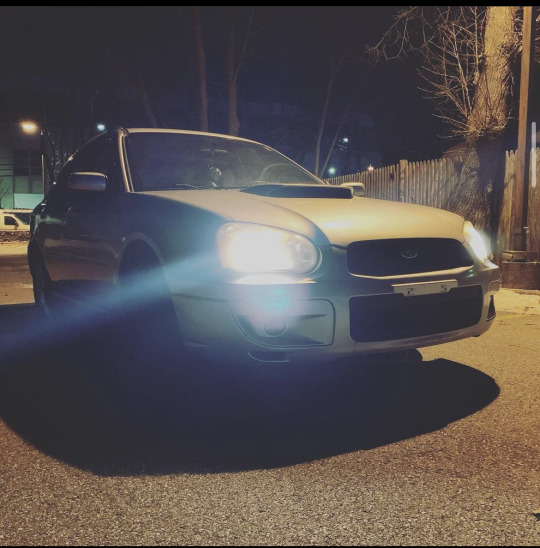
and then for some reason my mom gave me a sports car. she bought a new honda civic and handed down her 2004 subaru wrx wagon, with the manual transmission and everything. she’d named it the millennium falcon so i called her falcon. this car was a blast to whip around. that turbo boxer engine sounded amazing and this thing RIPPED on the highway. the biggest issues with it were that it really didn’t have all that much character on the road, and it took premium gas, so fill ups were EXPENSIVE. i sold her after having her for a few months because the clutch went out and i was quoted $2k to replace it because that’s what happens when you have a sports car. sold it as is to a guy with two other wrxs who wanted to fix it up and use it as a work car
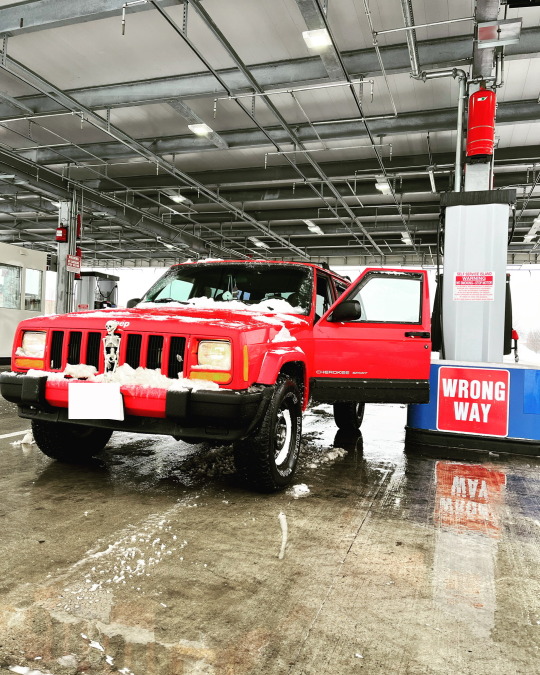
this is the current baby! bit of an older picture because she looks uhhh worse these days but this is clifford jr the 2001 jeep cherokee xj. i’ve learned so much with this car, done a bunch of the work on her myself. she’s a fixer upper im reaching my limit on but she’s served me remarkably well and is my favorite car i’ve owned. not fast, not good on gas, but god she’s got some character. just rolled over 256k miles
like i said i’m reaching my wits end with the jeep, every time i fix something two more things break, and i can’t afford for her to keep being a money pit. so i’m starting to save for something else, ideally a late 80s honda or toyota, or a panther body sedan, like a ford crown victoria or mercury grand marquis
99 notes
·
View notes
Text
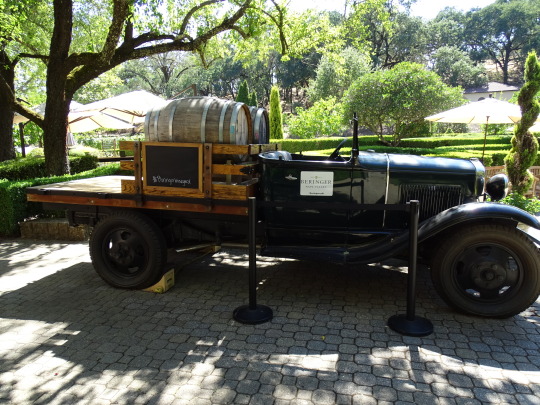
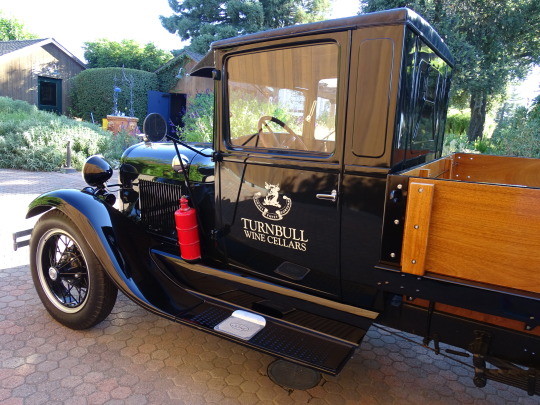
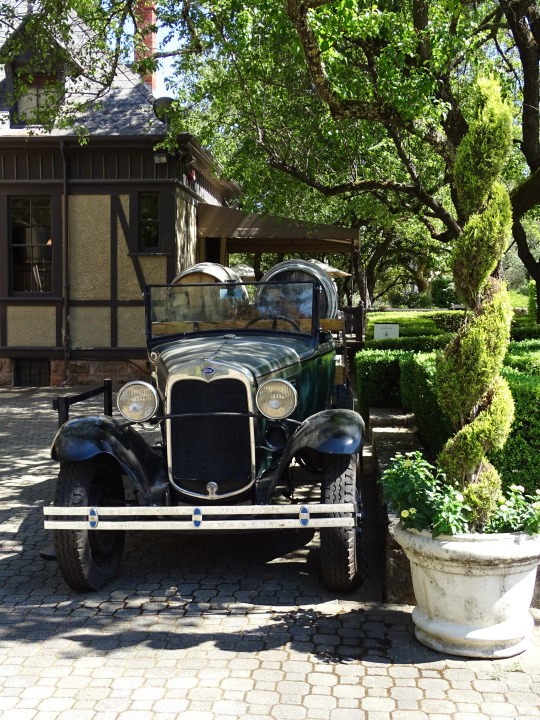






Model T Day
Model T Day is a lively celebration of the iconic car that changed the way Americans traveled. This day is all about honoring the Model T, which was the first mass-produced automobile that made car travel affordable for many people.
The Model T, introduced by Henry Ford, symbolizes innovation and the start of modern personal transportation.
It’s a day to appreciate how this car transformed society by making it easier for families to own a vehicle and travel freely.
The significance of Model T Day lies in its celebration of technological progress and affordability in automotive history.
Henry Ford’s introduction of the moving assembly line revolutionized car manufacturing, significantly lowering costs and making cars accessible to the average American.
This shift not only boosted the economy but also changed everyday life, allowing people to travel farther and faster than ever before. Celebrating Model T Day reminds us of these advancements and the impact of innovation on our daily lives.
Model T Day also inspires inventors and innovators, encouraging them to pursue their dreams and make lasting impacts on the world.
Additionally, it fosters a sense of nostalgia and appreciation for historical advancements, highlighting how far technology has come and its role in shaping the modern world.
History of Model T Day
Model T Day started as a way to honor the revolutionary car created by Henry Ford. This day was first celebrated to recognize the impact of the Model T on society and transportation.
It officially began in the early 2000s, initiated by automotive enthusiasts and historical societies. They wanted to highlight the importance of this vehicle in American history.
The celebration acknowledges how the Model T made car ownership possible for many people. Before its introduction, cars were a luxury few could afford.
The Model T’s affordability and Ford’s innovative assembly line changed that, allowing millions of Americans to own a car. This shift played a significant role in shaping modern transportation and industry.
Henry Ford’s vision and dedication to making cars accessible to everyone is a core reason for this celebration.
The Model T wasn’t just a car; it was a symbol of innovation and progress. Celebrating Model T Day reminds us of the transformative power of technology and the importance of making advancements that benefit everyone.
How to Celebrate Model T Day
Host a Vintage Car Parade
Picture a parade, but instead of floats, imagine vintage cars! Enthusiasts can line up their cherished Model Ts and drive them through town.
Neighbors will cheer, and cameras will click as these historic vehicles roll by, showcasing their charm and elegance.
Organize a Model T Quiz Night
Quizzes aren’t just for pubs! Gather friends and family for a fun-filled trivia night focused on the Model T. Prepare questions about its history, fun facts, and quirky details.
The winner gets bragging rights as the ultimate Model T expert!
Plan a Picnic with a Twist
Pack a picnic and head to a local park, but with a twist – everyone dresses in early 1900s attire! Enjoy sandwiches, lemonade, and a game of horseshoes.
Bonus points for anyone who arrives in a Model T, of course!
Create a DIY Workshop
Turn your garage into a Model T workshop for the day. Invite friends to learn about basic car maintenance, especially those with vintage car models.
Share tips, tools, and tales while tinkering with your beloved automobiles.
Film Screening Under the Stars
Host an outdoor movie night featuring documentaries or films about the Model T and Henry Ford. Lay out blankets, set up a projector, and enjoy learning about automotive history under the stars. Popcorn is a must!
Teach the Young Ones
Share the Model T magic with kids and teens. Organize a storytelling session about how the Model T changed the world.
Use photos, videos, and even toy models to make history come alive for the younger generation.
Visit a Local Museum
Plan a trip to a nearby car museum. Many museums feature classic cars, including the Model T. Walking among these historic vehicles provides a tangible connection to the past and inspires appreciation for automotive innovation.
Decorate Your Model T
If you own a Model T, get creative! Decorate it with period-appropriate accessories like old luggage, picnic baskets, and vintage clothing.
Then, take it for a spin around the neighborhood to share your creation with everyone.
Source
#Turnbull Wine Cellars#Oakville#Beringer Vineyards#St Helena#Napa Valley#California#summer 2024#travel#original photography#vacation#tourist attraction#landmark#cityscape#Bay Area#West Coast#2023#old car#technology#engineering#Model T Day#1 October#USA#ModelTDay
2 notes
·
View notes
Text
Beasts of Burden

Parked on a street in Chinatown, Bangkok. Vintage unknown. It has been there for decades, has licence plates and is in driveable condition as far as I can tell.
. . . .
It is easy to get nostalgic about old Land Rovers. Everything about them contradicts the 21st century. They are or were basic machines with heavy steel frames and aluminium bodies that were riveted together. The passing of time did not seem to affect them.
Introduced in 1948 and made in what was then the heartland of English car manufacturing (Coventry, Solihull), they stood for a less complicated time when everything was mechanical and nothing was virtual.
Eventually economic reasoning caught up and production was halted in 2016. I remember wistfully looking at some of the last remaining models sitting in dealers' showrooms in such remote places as Ponta Delgado (in the Azores) or Suva (in Fiji). By then Land Rover was no longer very British. Ownership of the brand had shifted to BMW in 1994, then to Ford before being sold to the Indian Tata conglomerate in 2008.
. . . .

The real thing, Santanas, in Andalusia.
Classic Land Rovers are in essence farm vehicles. As such they have remained a common sight in the countryside of southern Spain, their colour the same as the dry Andaluz soil at the height of summer. Wherever olives grow you will find Land Rovers, especially the Spanish variant which was built for many years under license by Santana.
Long before production ended, Land Rovers had also become yuppie toys, often in gleaming black. Worse, the new owners of the brand decided that even if the vehicle no longer made commercial sense, the name and the outdoorsy mystique were worth preserving.

Imagine my irritation when I was confronted, some weeks ago, with this reality, the ultimate in urban sophistication on wheels, parked on a street in Nagoya, Japan (above). Notice the subtle pastel paint job which actually refers to the early production models, painted the same green as commercial aircraft before delivery. It was the only paint they could find in postwar Britain, the legend goes.
I suppose it was inevitable that Land Rovers would go the way of the Range Rover. It started off more than fifty years ago as a country squire's all terrain vehicle, designed to take the bumps. Although it was a definite step up from the Land Rover, it still had solid axles front and rear, and a manual gearbox. But over the years it evolved to its current status as the rich person's SUV-limousine of choice with price tags exceeding a quarter of a million euros. But the old ones are still around, farm vehicles once more, popular with sheep farmers and wine growers.

Object of enduring fantasy. Vintage Land Rover Defender with all the trimmings on a street in Turin, Italy, June 2024.
2 notes
·
View notes
Text
The Evolution of Sports Cars: From Classic to Modern
The world of sports cars has undergone a dramatic transformation since its inception. What started as vehicles designed for speed and performance has become a symbol of luxury, innovation, and status. From classic beauties like the Ferrari 250 GTO to cutting-edge marvels like the Porsche 911 GT3, the evolution of sports cars reflects advancements in technology, engineering, and consumer demand.
Early Sports Cars: A Focus on Speed and Design
The history of sports cars dates back to the early 20th century, with the emergence of brands like Bugatti and Alfa Romeo, which catered to a growing group of car enthusiasts. Early sports cars emphasized speed and aesthetics, but they lacked many of the safety and convenience features found in modern vehicles. These cars were often hand-built, making each model unique in terms of design and performance.
For example, the 1930s Bugatti Type 57SC Atlantic is revered for its aerodynamic design and powerful engine. However, it was a far cry from the reliable, high-tech machines we know today. Early sports cars were also notoriously challenging to drive, requiring skill and precision to manage their raw power.
Post-War Boom: The Birth of Iconic Models
After World War II, the automotive industry experienced a boom, and the sports car category exploded in popularity. The 1950s and 1960s brought us some of the most iconic models in automotive history, including the Jaguar E-Type and the Ferrari 250 GTO. These cars not only excelled in performance but also set new standards for design. The Jaguar E-Type, in particular, became known for its sleek body, which was considered ahead of its time.
This era also saw the rise of American muscle cars like the Ford Mustang and Chevrolet Corvette, which blurred the lines between sports cars and muscle machines. These cars offered high horsepower at a relatively affordable price, making sports car ownership accessible to a wider audience.
The Technological Revolution: 1980s to 2000s
By the 1980s, sports cars started incorporating new technologies aimed at enhancing both performance and safety. Features like anti-lock brakes, fuel injection systems, and more aerodynamic designs became standard. Cars like the Porsche 911 Turbo and Ferrari Testarossa pushed the envelope with top speeds exceeding 150 mph while still maintaining comfort for everyday driving.
The 1990s and early 2000s brought further advancements with the introduction of electronic stability control, advanced suspension systems, and turbocharging. This period also saw the introduction of hypercars like the McLaren F1, which could reach speeds of over 240 mph, setting a new standard for what sports cars could achieve.
Modern Sports Cars: A Blend of Luxury and Innovation
Today’s sports cars represent the pinnacle of automotive engineering. Modern sports cars not only prioritize speed and performance but also offer unparalleled comfort, safety, and technological integration. Features like adaptive suspension, carbon fiber bodies, and hybrid powertrains are commonplace in today’s high-performance vehicles.
Electric sports cars like the Tesla Roadster and the Rimac Nevera are redefining what it means to be a sports car. These vehicles combine instant torque with zero emissions, offering a glimpse into the future of sustainable high-performance driving. At the same time, traditional manufacturers like Ferrari and Lamborghini continue to push the boundaries of speed and luxury with their flagship models.
Conclusion: The Future of Sports Cars
The evolution of sports cars is far from over. As we move toward an era of electric and autonomous vehicles, the sports car industry will need to adapt once again. However, one thing remains certain—sports cars will continue to capture the hearts of enthusiasts worldwide, offering a unique blend of speed, design, and innovation that is unmatched by any other vehicle category.
0 notes
Text
Automobiles: Transforming Transportation and Connectivity

Automobiles: Transforming Transportation and Connectivity
Automobiles have revolutionized the way humans live, work, and connect. These marvels of engineering are not just vehicles; they are symbols of freedom, convenience, and technological advancement. From their invention in the late 19th century to the sleek, electric, and self-driving models of today, automobiles have significantly shaped modern society.
If you're looking to buy or sell vehicles in India, particularly in Gujarat, platforms offering Classified Ads Surat have emerged as go-to resources for connecting buyers and sellers. Let’s explore the automobile industry’s evolution, its impact on society, and how classified ad platforms enhance the buying and selling experience.
The Evolution of Automobiles
The journey of automobiles began in the 1880s when Karl Benz introduced the first petrol-powered car. Over time, advancements in engineering and design have led to the production of efficient, safer, and more sophisticated vehicles. In the early 20th century, Henry Ford’s assembly line revolutionized car manufacturing, making automobiles accessible to the masses.
Today, the industry is moving toward electric and hybrid vehicles to address environmental concerns. Brands like Tesla, Tata Motors, and Toyota are leading this change, creating cars that are not only energy-efficient but also technologically advanced. From fuel efficiency to cutting-edge infotainment systems, modern automobiles cater to a wide range of preferences and budgets.
Automobiles and Society
Automobiles have become indispensable in daily life. They provide convenience for personal and professional commutes, enable economic activities like goods transportation, and facilitate emergency services. Beyond functionality, vehicles often represent a status symbol, reflecting lifestyle choices and aspirations.
In cities like Surat, where rapid urbanization has led to increasing transportation needs, the demand for automobiles is ever-growing. However, buying a car is a significant financial decision, and finding the right vehicle at the right price can be challenging. This is where Classified Ads Surat becomes an essential tool for consumers.
The Role of Classified Ads in Surat's Automobile Market
The classified ads industry has grown tremendously, offering a digital solution for buying and selling automobiles. Whether you’re searching for a brand-new car, a reliable second-hand vehicle, or even automotive parts, platforms featuring Classified Ads Surat provide a seamless experience.
Here’s why classified ads are crucial for automobile transactions:
Wide Range of Options: Buyers can browse hundreds of listings for cars, bikes, and scooters, filtering based on budget, brand, model, and year of manufacture.
Affordable Deals: Sellers often list their vehicles at competitive prices, providing buyers an opportunity to negotiate directly.
Convenience: Online platforms save time and effort by enabling users to access listings from the comfort of their homes.
Transparency: Many listings come with detailed descriptions, photographs, and contact information, allowing for informed decision-making.
Local Connections: Platforms focused on regions like Surat help buyers and sellers connect locally, minimizing logistics and ensuring easier transactions.
Future Trends in Automobiles
As the automobile industry continues to evolve, some key trends include:
Electric Vehicles (EVs): With a push toward sustainability, EVs are gaining popularity. They offer reduced emissions and lower operational costs, making them an excellent choice for eco-conscious buyers.
Autonomous Cars: Self-driving technology is on the rise, promising to transform how people travel and interact with vehicles.
Shared Mobility: Car-sharing services are becoming a practical solution for urban mobility, reducing the need for individual car ownership.
Digital Integration: Smart cars equipped with internet connectivity, AI, and voice assistants are the future of mobility.
Conclusion
Automobiles will always play a central role in modern life, symbolizing progress and innovation. For buyers and sellers in Surat, platforms promoting classified ads Surat offer a convenient and efficient way to navigate the local automobile market. As technology advances and consumer needs evolve, these platforms will become even more integral to facilitating automobile transactions.
Whether you’re looking for a compact sedan, a sturdy SUV, or a budget-friendly scooter, Surat’s classified ads can connect you to the perfect option. So, embrace the convenience of modern technology and explore the world of automobiles with just a click!
0 notes
Note
Ooo, more early ownership Ford plz???

What if we burnt Bill Cipher to a crisp
#gravity falls#gravity falls au#domesticated ford#ford pines#stanford pines#my art#fanart#sketch#ask#bill cipher#bill cipher fucking sucks#tw abuse#tw torture#heavily implied
221 notes
·
View notes
Text
The Legacy and Innovation of Ford Cars
Introduction:
When it comes to the automotive industry, few names resonate as strongly as Ford. Founded in 1903 by Henry Ford and a group of investors, the Ford Motor Company revolutionised transportation and manufacturing processes, forever changing the landscape of the automotive world. Over the years, Ford has produced a wide range of vehicles, from trucks and SUVs to electric cars, each with a unique blend of innovation, performance, and style. This article explores the history, key models, technological advancements, and future of Ford cars.
A Historical Perspective:
Ford's journey began with the introduction of the Model T in 1908, a vehicle that made car ownership accessible to the masses. Its affordability and reliability transformed American society, enabling people to travel greater distances and changing the dynamics of daily life. The Model T was not just a car; it was a symbol of freedom and mobility.
The company was also a pioneer in manufacturing techniques. The introduction of the moving assembly line in 1913 revolutionised production, drastically reducing the time it took to build a car and allowing for mass production. This innovation not only lowered costs but also set a standard for manufacturing practices in various industries.
Iconic Models:
Over the decades, Ford has produced numerous iconic models that have become synonymous with American culture.
Ford Mustang: Introduced in 1964, the Mustang redefined the concept of the "pony car." With its sporty design and powerful engine options, it quickly became a symbol of youthful rebellion and freedom. The Mustang has seen numerous iterations, each one building on its legacy while incorporating modern technology and performance enhancements.
Ford F-Series: The F-Series trucks, particularly the F-150, have been a staple in the American truck market for decades. Known for their durability and versatility, F-Series trucks are often favoured by both construction workers and everyday consumers alike. The F-150 has consistently ranked as one of the best-selling vehicles in the U.S., showcasing Ford's ability to meet consumer demands for both work and leisure.
Ford Explorer: As one of the pioneers of the SUV segment in the early 1990s, the Explorer has played a significant role in popularising sport utility vehicles. With its spacious interior and off-road capabilities, the Explorer became a family favourite, blending functionality with comfort.
Ford Focus: Launched in the late 1990s, the Focus became a benchmark for compact cars. Its agile handling, fuel efficiency, and affordability made it a popular choice among young drivers and those looking for a reliable daily driver. The Focus has evolved over the years, embracing new technologies while maintaining its core attributes.
Technological Innovations:
Ford has consistently been at the forefront of automotive technology. The company has made significant strides in various areas, including safety, fuel efficiency, and connectivity.
EcoBoost Engines: Ford's EcoBoost technology is designed to improve fuel efficiency without sacrificing performance. By using turbocharging and direct fuel injection, these engines deliver power comparable to larger engines while reducing carbon emissions. This technology has been integrated into many Ford models, appealing to environmentally conscious consumers.
Ford Co-Pilot360: This suite of advanced driver-assist features represents Ford's commitment to safety. It includes technologies such as automatic emergency braking, blind-spot monitoring, lane-keeping assist, and adaptive cruise control. These features not only enhance safety but also make driving more enjoyable and less stressful.
Connectivity and Infotainment: Ford has embraced technology with its SYNC infotainment system, which allows drivers to integrate their smartphones and access navigation, music, and other features through voice commands. This focus on connectivity ensures that drivers stay informed and entertained on the road.
Electric Vehicles: As the automotive industry shifts towards sustainability, Ford is making significant investments in electric vehicles (EVs). The launch of the all-electric Ford Mustang Mach-E and the electric F-150 Lightning signifies the company’s commitment to a greener future. These vehicles not only deliver impressive performance but also aim to reduce the environmental impact of transportation.
Ford’s Commitment to Sustainability:
In addition to producing electric vehicles, Ford is taking steps to ensure its manufacturing processes are more sustainable. The company has set ambitious goals, including achieving carbon neutrality globally by 2050 and reducing greenhouse gas emissions from its vehicles. Ford is also working to increase the use of recycled materials in production and reduce water usage in manufacturing plants.
The Future of Ford Cars:
Looking ahead, Ford is poised to remain a key player in the automotive industry. With the shift towards electrification, autonomous driving, and smart mobility, Ford is adapting to meet the demands of modern consumers. The company’s investment in research and development indicates a focus on innovation, ensuring that it stays relevant in a rapidly evolving market.
Ford is also exploring new business models, including ride-sharing and vehicle subscription services, reflecting changes in consumer preferences and urban mobility trends. As cities become more congested and environmentally conscious, Ford aims to provide solutions that enhance transportation options.
Conclusion:
Ford's legacy is built on innovation, quality, and a commitment to meeting the needs of its customers. From the historic Model T to the cutting-edge electric vehicles of today, Ford continues to shape the automotive landscape. As the company embraces new technologies and sustainable practices, it remains dedicated to producing vehicles that not only perform well but also contribute positively to society and the environment.
Whether you’re a fan of muscle cars, rugged trucks, or efficient compact vehicles, Ford has something to offer. As the automotive industry continues to evolve, one thing is certain: Ford will be at the forefront, driving the future of mobility.
1 note
·
View note
Text
Eddie and Lina
So, this is about my Great Uncle and Aunt, in America, 2810, 36th street Astoria, New York. My great Uncle, was my grandmother's brother. I'm not sure whether he was half-brother or brother, and he went to New York. I don’t know why he went to New York, make his fortune, I suppose. But he didn't do that. He ended up being ripped off. He jumped ship, that's right, he must been in a navy, so he jumped ship, and he was hiding out with other, so he must’ve jumped ship in America, and he was hiding out with other Maltese. There was a Maltese enclave in Astoria, I found out and he jumped ship and he was living with them and they were ripping him off wholesale, apparently.
Not quite sure how he got together with Aunt Lina, but he was an office cleaner or a window cleaner, one of the other.
My aunt had adopted a boy called Howard. Apparently, when he grew up, he joined the Army and when he came back from his tours of duty, he didn’t want to know Eddie or Lina is video Lina and never heard of him again. We never know him anyway; I think we got a photo in somewhere.
Somewhere along the line, and I don’t know how they managed this on that kind of money; because he can't have been on great money doing window cleaning, but they had a summer place which a lot of New Yorkers did. In the summer, they leave a city and go out to Staten Island and so they had this place I could remember it well in Staten Island. They owned other parts of Staten Island and they must’ve bought it up really cheap at some stage, and other people had places on there and they used to collect rent off of that.
Eddie enjoyed fishing and there were many photos of him and his pals in a small boat out on the water. He gave me a split cane boat rod and reel, although ownership is questioned. Both stayed in M&Ds bedroom collecting dust for decades. Much later, I took it to work where a guy restored the reel. Dad asked for it back and promptly gave it away. Why do that?
Eddie and Lina came to the UK early to mid-60’s with Nancy. I remember dad renting a Ford Zephyr 6 to go get them from the airport which I can’t see was much bigger than the Morris Oxford he then owned but we learned long ago that logic evaded him.
When we went over, in 1968, just after my grandad died, dad wasn't supposed to come with us and they were supposed to look after each other or something. I can't remember exactly what it was. So, in the end he decided to come with us, we went over and stayed at 2810, 36th street for a week, and 2 weeks out of the city in Staten Island. Interestingly, we were in NYC early June 1968 as Bobby Kennedy was laying in state in St. Patricks Cathedral 6-8 June 1968. [PT]
Anyway, coming into JFK but we didn’t really do much in the city. We hung around the apartment in Astoria a lot, we didn’t seem to go anywhere. However, we did go for one evening to my aunts’ Irish friends, the Collins. I can remember them asking if I wanted a drink and I said yes and that was an end to it. I waited for them to get me something and they expected me to do self-service.
They also had a color TV and I remember watching Tarzan [the Ron Ely version] and the color was so bad that Tarzan was running in B&W and behind him running was the color, never actually catching up.
We went into the city for at least a day because we have photos of the UN building, we went up the Empire State building and we visited the big stores. I can remember being in a café or diner when a cop walked in and sat close by. I was transfixed with the gun on his hip. We also went to Radio City Music Hall and watched the Odd Couple with Jack Lemmon and Walter Matthau which was brand new at that time. There were dancing girls akin to the UK TV show, Sunday Night at the London Palladium. I remember my aunt having a fit as there were a bunch of nuns in the audience. Different times
I do remember buying Captain Action previously in New York City from either JCPenney or one of the other big boys. You know, Macy's somewhere like that. I’ve still got him. Because I was already a fan of the DC comics and Batman and Superman. It was in these comics that I discovered Captain Action as he was advertised in there, that's what I wanted. You couldn’t buy him in England. So I bought him and a Superman costume because he was being able to change between superman, Batman Green Hornet Spider-Man. God knows how it worked with copyright for all the different companies involved.
I remember the rubber band inside that held him together, pinged off so dad had to mend that. It was actually one of the things that he got right because it's been alright ever since it's still upstairs, this is rambling, isn't it?
So, my aunt was a great cook, so mum said, but then anyone who could make a slice of toast without burning it was a great cook to my mum.
At some stage, we went up to Sonny’s farm. Now Sonny’s farm was upstate New York. It was a chicken farm or egg farm whichever, and there is movie of that as well. And he was a big big fellow with a big cigar, he came down to pick us up in, I think, it was a Ford Fairlane, got us all in anyway and drove us back up to the farm. On the way he managed to get in the wrong lane when something was happening ahead and the policeman that was directing traffic told him to turn one way and Sonny said ‘but I don’t wanna go that way, I wanna go over there’. The cop wasn’t having any of it and Sonny had to comply.
Some say his wife was a drunk, I don't know, but anyway he was a big boy. I remember her cooking in this frying pan that which was almost flat with the amount of charred whatever in it. Food tasted ok though to a 10-year-old.
One of the days we were there, Sonny fired up the BBQ and cooked steak. Dad took a [out of focus] photo of the raw meat with a pack of Peter Stuyvesant cigarettes to show the size of the meat. Once again there is film of this BBQ
The ranch had a snow sledge in the middle of the green and there is film of us riding one of their horses.
We had fun because his kids had bicycles and they were at school, so me and my brother had to hang out together and we use their bicycles. Of course, we had never come across banana seat bicycles before with cow horn handlebars, classic American bicycle, the Schwinn. The back brake was pedal backwards which locked the rear wheel. We had great fun riding down from the chicken shed, down the slope and getting to the bottom and it was all gravel and we were able to pedal backwards and skid which is also captured on film. It was fun for us at 10 and 8 years old.
Sonny had a trotting track which was curiously American invention where you have buggies and the rider sits on the back and the horses aren't allowed to gallop, they have to trot, so it's a specific thing. So, he's getting the track ready for the new season. He had this ex-military Willy's Jeep that he [I think] attached an old bed spring to the back of the Jeep and dragged it round the track. This was to soften the track and to even it out after the winter, I guess. Also, on film. We weren’t there for any of the races
I can't even remember coming back from there, but we did and someone, maybe Mrs Collins, those were the Irish friends from Astoria.
Astoria was a combination just like our family, really, between Irish and Maltese. Anyway, I am fairly sure they gave us a lift to Staten Island as I remember going by car.
Whilst in Staten Island, my aunt's friend came over, Sally and her kids and 2nd husband. Doug, Sally’s first husband, died just after having a medical examination that showed he was in good health. Her 2nd husband was a typical American, long thin. He shot himself at some stage. I think he was an alcoholic and he shot himself and so as his wife.
They came over with Nancy and the other kids and of course I had a crush on Nancy from previous when they’d come to England. And that was the first we’d seen of Polaroids and instant photos and tape recorders. We’ve got some Polaroids which [mum said] were meant not to last but 55+ years later they’re still around; how long do you want a photo to last? So here we had a fun with them.
My Uncle had a stroke and he wasn't very mobile at all. So, most things were being done around him.
So, I could remember going round with my aunt to these different places. I think as Mrs Messenger or someone, maybe that was in New York can’t remember. I remember going to the garage at this guy’s place. It was a massive garage and it was like the size of downstairs of Jenkins Grove with all the walls knocked down and probably bigger than that. Tools all methodically stored and spotlessly clean anyway, it's beside the point.
Now, as I remember Staten Island it was a wooden building, like a static. Bigger than one of our statics mind you. It had an outside toilet and there was no drainage. So, you had the outside toilet, a little wooden shack that you could barely turn around in a board across the back end of it with a seat with a hole. I kind of remember blue but god knows; perhaps that would be in one of the films the old man took anyway.
It was a good thing to go take a crap in the morning because the bucket was empty. Basically, a big tin bucket and you go round the back of the outside toilet open this hatch and pull this bucket out which is which by the end of the day, is you know, basically like most Tories full of shit. That's why it's advisable to go to the toilet in the morning. Because the higher it got, and the lower you dangled and the later you leave it, the more chance of the 2 meeting. Lina got dad to dig a pit to throw the contents of the bucket in. Great holiday pastime.
I could remember going over there to open the place up. It had shutters on the windows and we had to take all the shutters down. We had to go over by the Staten Island ferry, there’s photos of me and my brother going over past the Statue of Liberty. We had little knowledge of any of this stuff back in ‘68, you know.
I can remember opening up and the part that was actually Eddie and Linas had a long strip of grass all the way down to the ocean, their own private beach on the ocean and a little pier I remember. It was a little sandy beach and so in the water was these, I don’t know what they’re really called, but we call them horseshoe crabs and they had a big shell on the back and a big spiky tail that if you trod on the shell, the tail went up in the air and your next step that went straight through your foot. Not sure how that would happen, actually, because if you tread on the thing, then you're quite safe as a thing, comes up. Your next step isn't going to be, you know an inch, is it? Anyway, we used to get the drift wood on the beach. One of our jobs when we first got there was to get all the drift wood off of the beach and pile it up and we made a bonfire.
Anyway, me and Pete used to go down to the pier with some of this driftwood and used to kill these bloody crabs through the water, just smash them on the back. We were really environmentalists at the time, you know real nature conservationists and all that crap. It's what kids do isn’t it?
That’s where my hatred of melons came from. My aunt bought some melon, it probably wasn't the melon, but I remember eating melon over there and being sick, you know bad and I didn't eat melon again. Never, even the smell used to make me wretch. So, I didn't eat melon again until I met Althia in 2017 and I don't know what made me then, she just bought it, you know, so I just ate it, and it was fine, took a bit of nerve, but I did it anyway I digress.
I don't remember much about the inside of the place on Staten Island; obviously, there were bedrooms not sure there were enough bedrooms for all of us. There would be a bedroom for me and Pete, Granny, a bedroom for my aunt and Uncle bedroom for mum and dad.
Then we heard that Uncle Eddie had died and Lina went into about a million years’ worth of grief. So, I remember mum getting letters from Lina which were rambling on about how much she missed her Eddie and all that crap.
Lina and our maternal grandmother went on a tour which involved a stay in Malta at some stage, they were both widows by then.
Then we don't know what I'm not sure what happened. Don't know when she died, don’t know what happened after she died. I don't know how we knew that she died, not sure that mum didn't write to Mrs Collins or someone and find out that's as much as I know about them.
with help from Pete
Sept 2024
0 notes
Text
US labour market downward revision cements Sep cut
US stocks ended modestly higher on Wednesday as minutes from July’s Federal Reserve meeting cemented expectations for a rate cut next month, allaying earlier fears over the economic picture after downward revisions to labour market data.
The market had been cautious early on after the Bureau of Labor Statistics lowered its estimate for total payroll employment for the period from April 2023 to March 2024 by 818,000, as part of the agency’s annual benchmark review of jobs data, with the move reviving faint recession fears.

But then the July Fed meeting minutes showed the "vast majority" of Federal Reserve policymakers signalled that it may be appropriate to begin cutting rates in September should the recent progress on inflation continue, and that gave Wall Street a late boost.
The minutes and data come ahead of Fed chair Jerome Powell's keynote speech at the economic symposium at Jackson Hole on Friday. Investors expect Powell to provide more dovish cues on rates, although he is not expected to explicitly outline plans for a reduction in September.
At the close in New York, the blue-chip Dow Jones Industrials Average was 0.1% higher at 40,890, while the broader S&P 500 index added 0.4% at 5,620, and the tech-laden Nasdaq Composite rose 0.6% to 17,918.

SPX500 H1

DXY H1
Driving ahead, Ford Motor gained 1.6% after announcing that it is to scrap its planned three-row electric SUV and delay the roll out of a new F-150 truck due to softer demand.
Meanwhile, Chinese eCommerce firm JD.com shed 8.7% after news reports said Walmart planned to sell its stake in the company for about $3.7 billion.
In the earnings spotlight, Keysight Technologies jumped 19.2% after its earnings beat estimates.
Retail giant Target gained 11.3% after the firm raised its annual profit forecast and beat expectations for second-quarter comparable sales.
But in contrast, department store chain Macy’s dropped 16.9% after it missed market expectations for quarterly revenue. And furniture maker La-Z-Boy lost 3.5% as weaker-than-expected guidance largely offset strong earnings.
On the commodities front, oil prices fell on worries about demand following the revised US jobs data and given fears about China's weakened economy. That offset any supply support from a drop in US oil inventories.

UKOIL H1
UK Brent crude dropped 1.3% to $75.13 a barrel, while US West Texas Intermediate shed 1.7% to $71.94 a barrel.
Disclaimer:
The information contained in this market commentary is of general nature only and does not take into account your objectives, financial situation or needs. You are strongly recommended to seek independent financial advice before making any investment decisions.
Trading margin forex and CFDs carries a high level of risk and may not be suitable for all investors. Investors could experience losses in excess of total deposits. You do not have ownership of the underlying assets. AC Capital Market (V) Ltd is the product issuer and distributor. Please read and consider our Product Disclosure Statement and Terms and Conditions, and fully understand the risks involved before deciding to acquire any of the financial products provided by us.
The content of this market commentary is owned by AC Capital Market (V) Ltd. Any illegal reproduction of this content will result in immediate legal action.
0 notes
Text
Riding the Waves of Innovation: From Horse Carriages to Electric Vehicles – Unveiling the Evolution with PRWireNow

The Evolution of the Automotive Industry: From Horse Carriages to Electric Vehicles
The automotive industry has journeyed from its humble beginnings with horse-drawn carriages to the cutting-edge era of electric vehicles (EVs). This evolution spans over a century of technological innovation, economic shifts, and environmental considerations.
Early Beginnings: Horse Carriages to Motor Vehicles
The automotive industry traces its roots to the late 19th century, marked by the invention of the first practical automobile by Karl Benz in 1886. This invention replaced the traditional horse-drawn carriages, revolutionizing transportation with internal combustion engines. Henry Ford's introduction of assembly line production in 1913 further democratized car ownership, making vehicles more affordable and accessible to the masses.
The Rise of Combustion Engines and Global Expansion
Throughout the early to mid-20th century, advancements in combustion engine technology drove rapid growth in the automotive sector. Companies like Ford, General Motors, and Chrysler became synonymous with automotive innovation and mass production. This period also saw the rise of iconic vehicles such as the Ford Model T and Chevrolet Corvette, which captured the imagination of consumers worldwide.
Shift towards Efficiency and Sustainability
The latter half of the 20th century brought challenges such as environmental concerns and oil crises, prompting a shift towards more fuel-efficient vehicles. Japanese automakers like Toyota and Honda gained prominence for their emphasis on reliability and fuel efficiency, challenging the dominance of American and European manufacturers.
Emergence of Electric Vehicles (EVs) and Sustainable Mobility
In recent decades, environmental awareness and technological advancements have driven the resurgence of electric vehicles (EVs). The development of lithium-ion batteries and improvements in charging infrastructure have made EVs more practical and appealing to consumers. Companies like Tesla have spearheaded this movement, combining innovation with sustainability to redefine the automotive landscape.
The Future: Autonomous Driving and Beyond
Looking ahead, the automotive industry is poised for further transformation with the advent of autonomous driving technology. AI and machine learning are paving the way for vehicles capable of navigating roads autonomously, promising increased safety and efficiency. Moreover, concepts like connected vehicles and smart cities are set to redefine urban mobility, creating a more integrated and sustainable transportation ecosystem.
From its origins with horse carriages to the current era of electric vehicles and autonomous driving, the automotive industry has continuously evolved through innovation and adaptation. As society's priorities shift towards sustainability and technological advancement, the industry is poised to embrace new challenges and opportunities, shaping the future of mobility on a global scale.
#artificial intelligence#prwirenow#branding#marketing#automotive#automobile#suv#car#rolls royce#auto parts
0 notes
Text
The Evolution and Future of the Automobile Industry
The automobile industry, a cornerstone of modern transportation and economic development, has undergone significant transformations since its inception in the late 19th century. From the first gasoline-powered vehicles to the sophisticated electric and autonomous cars of today, the industry has continually evolved, driven by technological advancements, consumer demands, and environmental considerations.
Early Beginnings and Mass Production
The automobile's journey began with pioneers like Karl Benz, whose 1886 Benz Patent-Motorwagen is widely regarded as the first true automobile. Early cars were luxury items, handcrafted and expensive, accessible only to the wealthy. However, the introduction of assembly line production by Henry Ford in 1913 revolutionized the industry. Ford's Model T, produced efficiently and affordably, brought car ownership within reach of the average American. This mass production technique not only democratized car ownership but also set the stage for the automobile industry's rapid growth.
Post-War Expansion and Globalization
The post-World War II era marked a period of significant expansion and innovation in the automobile industry. The economic boom led to increased car ownership and the development of new markets. Japanese manufacturers like Toyota and Honda emerged, bringing competition and innovation to the global stage. They introduced efficient manufacturing processes such as Toyota's lean manufacturing, which emphasized waste reduction and continuous improvement.
During this period, cars became more than just a means of transportation; they became symbols of status and freedom. The 1950s and 1960s saw the rise of iconic models like the Chevrolet Corvette and the Ford Mustang, which captured the spirit of the age.
Environmental Concerns and Technological Advancements
By the 1970s, the industry faced new challenges, particularly environmental concerns and the oil crisis. These issues spurred the development of more fuel-efficient vehicles and stricter emission standards. The introduction of catalytic converters and advancements in engine technology helped reduce the environmental impact of cars.
The late 20th and early 21st centuries witnessed a technological revolution in the automobile industry. The integration of electronics and digital technologies led to the development of advanced safety features such as anti-lock braking systems (ABS), electronic stability control (ESC), and airbags. Additionally, the rise of computer-aided design (CAD) and manufacturing (CAM) enhanced the efficiency and precision of automobile production.
The Rise of Electric Vehicles and Autonomous Driving
In recent years, the most significant shift in the automobile industry has been the rise of electric vehicles (EVs). Driven by environmental concerns and advancements in battery technology, companies like Tesla have popularized EVs, pushing traditional automakers to accelerate their own electric vehicle programs. Governments worldwide are setting ambitious targets to phase out internal combustion engines in favor of electric vehicles to combat climate change.
Autonomous driving technology is another area of rapid development. Companies like Waymo, Uber, and major automakers are investing heavily in research and development to bring self-driving cars to market. These vehicles promise to enhance road safety, reduce traffic congestion, and provide greater mobility for the elderly and disabled. However, the widespread adoption of autonomous vehicles faces significant challenges, including regulatory hurdles, technological limitations, and public acceptance.
The Impact of Connectivity and Mobility Services
The convergence of the automobile industry with information technology has given rise to connected cars. These vehicles are equipped with internet connectivity and sensors, enabling them to communicate with other vehicles, infrastructure, and the cloud. Connected cars offer numerous benefits, including enhanced safety, optimized traffic flow, and personalized user experiences.
Moreover, the concept of mobility as a service (MaaS) is gaining traction. Instead of owning vehicles, consumers can now use ride-sharing services like Uber and Lyft, car-sharing services like Zipcar, and subscription-based models. This shift is changing the traditional notion of car ownership and is expected to reduce the number of vehicles on the road, alleviating urban congestion and reducing environmental impact.
Challenges and the Road Ahead
Despite its advancements, the automobile industry faces several challenges. The transition to electric vehicles requires significant investments in infrastructure, such as charging stations. Additionally, the industry must address cybersecurity concerns associated with connected and autonomous vehicles. Protecting vehicles from hacking and ensuring data privacy are critical issues that need to be addressed.
The COVID-19 pandemic also highlighted the industry's vulnerabilities, disrupting supply chains and production. However, it accelerated the adoption of digital technologies, such as virtual showrooms and online sales platforms, which are likely to remain integral to the industry.
Looking ahead, the automobile industry is poised for continued transformation. Advances in materials science, such as lightweight composites and 3D printing, will enhance vehicle performance and efficiency. Furthermore, the integration of artificial intelligence and machine learning will revolutionize vehicle design, manufacturing, and user experiences.
In conclusion, the automobile industry has come a long way from its early beginnings, continually adapting to technological advancements and societal changes. As it navigates the challenges and opportunities of the 21st century, the industry will play a crucial role in shaping the future of transportation and mobility. The road ahead is filled with possibilities, promising a more sustainable, connected, and autonomous driving experience.
1 note
·
View note
Text
Shifting Gears: The Dynamic World of Automobile Marketing
The automobile industry, a testament to human innovation and progress, thrives not just on engineering marvels but also on the strength of its marketing strategies. Over the decades, automobile marketing has evolved from simple print advertisements to sophisticated, data-driven campaigns that connect with consumers on multiple levels.
The Early Journey: Setting the Wheels in Motion
In the early 20th century, as automobiles began to replace horse-drawn carriages, marketing efforts focused on educating the public about this revolutionary mode of transport. Print ads in newspapers and magazines highlighted the convenience, speed, and freedom offered by cars. Brands like Ford and General Motors pioneered these early efforts, using compelling visuals and persuasive copy to attract buyers.
Television: The Golden Age of Car Commercials
With the advent of television, automobile marketing entered a new era. Car commercials became a staple of TV programming, featuring sleek, stylish vehicles gliding down open roads. These ads emphasized performance, luxury, and the aspirational aspects of car ownership. Iconic slogans and jingles became etched in the collective memory, helping brands like Chevrolet, Toyota, and Mercedes-Benz establish strong market identities.
The Digital Revolution: Engaging the Modern Consumer
The rise of the internet and digital technologies has revolutionized automobile marketing. Today, brands leverage a plethora of digital channels to reach their audiences. Social media platforms like Instagram, Facebook, and Twitter are now essential tools for engaging with consumers. These platforms allow brands to showcase new models, share user-generated content, and interact with fans in real time.
Moreover, search engine optimization (SEO) and targeted online ads have become critical components of automobile marketing. By analyzing consumer data, brands can tailor their messages to specific demographics, ensuring that potential buyers see the right content at the right time. This precision marketing approach increases the effectiveness of campaigns and drives higher conversion rates.
Innovative Approaches: VR, AR, and Interactive Experiences
In recent years, the integration of virtual reality (VR) and augmented reality (AR) has added a new dimension to automobile marketing. VR allows consumers to take virtual test drives, exploring every detail of a car's interior and exterior without leaving their homes. AR, on the other hand, enhances brochures and advertisements by overlaying digital information onto the physical world, providing an interactive experience that engages tech-savvy buyers.
Sustainability and Future Trends
As the world becomes more environmentally conscious, automobile marketing has also shifted its focus towards sustainability. Electric vehicles (EVs) and hybrid models are now central to many marketing campaigns. Brands emphasize the environmental benefits, lower operating costs, and advanced technology of these vehicles. This shift not only appeals to eco-conscious consumers but also aligns with global efforts to reduce carbon emissions.
Looking ahead, the future of automobile marketing will likely be shaped by advancements in artificial intelligence (AI) and machine learning. These technologies will enable even more personalized marketing experiences, as AI can analyze vast amounts of data to predict consumer preferences and behaviors. Additionally, the advent of autonomous vehicles will open new marketing avenues, as brands highlight the convenience, safety, and futuristic appeal of self-driving cars.
Conclusion
In conclusion, automobile marketing has undergone a remarkable transformation, adapting to changes in technology and consumer behavior. From the early days of print ads to the sophisticated digital campaigns of today, the goal remains the same: to connect with consumers and inspire them to take the wheel. As the industry continues to evolve, embracing new technologies and sustainable practices, automobile marketing will undoubtedly remain a dynamic and exciting field. The key to success lies in innovation, creativity, and a deep understanding of what drives consumer decisions.
0 notes